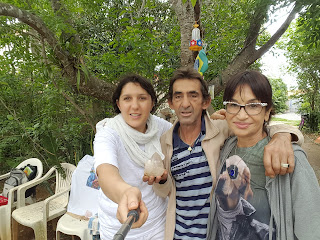Miracle Copaiba Oil from Amazonian Shamans, found me in Aadiania!
One day I felt urge to walk a small side street in Abadiania to explore. It was almost magnetic pull that took me all the way down to the end of the hill. On my way back I noticed a small entrance to the house and garden full of crystals and holy relics. There were two persons there and the man saw me and invited me to join them. I recognized the man as a volunteer at the Casa that had his miraculous healing. He couldn't walk at all, and with sincere service and change of the personality, he gain his healing.I saw the little video about him on the You tube some time ago.
His name is Joseph. He is a Amazonian shaman and very pious person. I was immediately attracted by his crystals that were natural, uncut, unpolished. And I got one cluster to take home.
There was a lady there that often come to visit him, and hear his stories and I heard later that she was the disciple of Marcel Vogel. The person that invented the famous Vogel cut for crystal wands and knew crystals inside out. The lady told me she is from Italy and just spent her holiday in Croatia.
Then she told me she comes to Joseph to buy the best quality, made directly from Amazonian shamans healing Copaibha oil. Then I knew why I've been brought there and I said I want to buy it also. No many people know about this oil, so I would like to share some informations about it.
I will be using it for my clients for massage and in my skin and oral care.It is very strong, and undiluted that you need just a drop or two of it! The oil is specially blessed by Joseph and is extra powerful. The people who can feel the energy, can feel the vibrations when holding it.
Copaiba allows us to see our emotional wounds and offers assistance with emotional clearing while providing spiritual protection. For those who combat stress at work or home, copaiba offers security and grounding. It assists us with staying in the moment rather than projecting backwards or forward. What Chakra is Affected? The solar plexus chakra. COPAIBA | ||
| Main Actions | Other Actions | Standard Dosage |
| Resin | ||
| Internal: 5-15 drops 2-3 | ||
| times daily | ||
| External: apply diluted resin | ||
| on affected areas | ||
TIVITIES AND CLINICAL RESEARCH
Copaiba trees are considerably branched and grow from
15-30 m high. They produce many small, white flowers on long panicles
and small fruit pods with 2-4 seeds inside. There are 35 species of Copaifera,
found mainly in tropical South America (particularly in Brazil,
Argentina, Bolivia, Guyana, Colombia, Peru, and Venezuela). Several
different species are used as traditional medicines interchangeably: C. langsdorffii is found mostly in the cerrados of central Brazil, C. reticulata is indigenous to the Amazon region, and C. officinalis occurs widely throughout South America, including the Amazon. All three varieties are used interchangeably.
The part of the tree that is often employed
medicinally is the oleoresin that accumulates in cavities within the
tree trunk. It is harvested by tapping or drilling holes into the wood
of the trunk and collecting the resin that drips out, much in the same
manner as harvesting maple syrup. A single copaiba tree can provide
about 40 liters of oleoresin annually, making it a sustainable
rainforest resource that can be harvested without destroying the tree or
the forest in which it grows. When tapped, the initial oily resin is
clear, thin, and colorless; it thickens and darkens upon contact with
air. Commercially sold resins are a thick, clear liquid, with a color
that varies from pale yellow to golden light brown. The variety gathered
in Venezuela is said to be thicker and darker in color. Although it is
often referred to a balsam or oil, it is actually a oleoresin.
TRIBAL AND HERBAL MEDICINE USES
On the Rio Solimoes in northwest Amazonia, copaiba
resin is used topically by indigenous tribes as a wound healer, to stop
bleeding, for skin sores and psoriasis, and to treat gonorrhea. Healers
and curanderos in the Amazon today use copaiba resin for all types of pain, for skin disorders and insect bites, and to cool inflammation.
In Brazilian herbal medicine systems the resin is
used as a strong antiseptic and expectorant for the respiratory tract
(including bronchitis and sinusitis), as an anti-inflammatory and
antiseptic for the urinary tract (for cystitis, bladder, and kidney
infections), as a topical anti-inflammatory agent for all types of skin
problems. Copaiba resin is sold in gel capsules in stores and pharmacies
in Brazil and recommended for all types of internal inflammation,
stomach ulcers and cancer. One of its more popular home-remedy uses in
Brazil is as an antiseptic gargle for sore throats and tonsillitis (15
drops of resin in warm water). In Peruvian traditional medicine, three
or four drops of the resin are mixed with a spoonful of honey and taken
as a natural sore throat remedy. It is also employed in Peruvian herbal
medicine systems to reduce inflammation and increase urination, and in
the treatment of incontinence, urinary problems, stomach ulcers,
syphilis, tetanus, bronchitis, catarrh, herpes, pleurisy, tuberculosis,
hemorrhages, and leishmaniasis (applied as a plaster).
Copaiba resin was first recorded in European
medicine in 1625 (brought back from the New World by the Jesuits and
called Jesuit's balsam) and has been used there since in the treatment
of chronic cystitis, bronchitis, chronic diarrhea, and as a topical
preparation for hemorrhoids. In the United States, it was an official
drug in the U. S. Pharmacopeia from 1820 to 1910. Noted ethnobotanist
and author Mark Plotkin reports that copaiba oil has been used in the
United States as a disinfectant, diuretic, laxative, and stimulant-in
addition to being used in cosmetics and soaps. The Encyclopedia of Common Natural Ingredients cites that copaiba has diuretic, antibacterial, anti-inflammatory, expectorant, disinfectant, and stimulant activities.
Much of the clinical research performed to date has
verified the traditional uses of copaiba. In 2002, researchers in Brazil
confirmed that it was highly effective as a topical wound healer in
animal studies. Long used internally and externally for inflammation of
all sorts, clinical research validates the resin's anti-inflammatory
effects against various laboratory-induced inflammation in other animal
studies. The anti-inflammatory effects have been related to the
sesquiterpene chemicals in copaiba oil which scientists have noted can
vary significantly-not only between different copaiba tree species, but
also within a given species and, even among individual trees.
Sesquiterpene content can range anywhere from 30-90%. This may account
for the results obtained by other Brazilian researchers who tested eight
different commercial samples of copaiba oil and only three of the eight
samples demonstrated significant anti-inflammatory effects. Of these
sesquiterpenes, caryophyllene is the most well studied, demonstrating
pain-relieving properties, antifungal properties against nail fungus, as
well as anti-inflammatory and gastroprotective properties in other
animal studies.
The gastroprotective effects of caryophyllene
documented in 1996 also help justify another traditional use of copaiba
oil - as a natural remedy for stomach ulcers. In this animal study, not
only did caryophyllene evidence significant anti-inflammatory effects
without any damage to the stomach lining (most other non-steroidal
anti-inflammatory agents cause stomach problems) - it actually
significantly inhibited stomach injury induced by various chemicals. Two
years later, another Brazilian research group reported that giving
natural copaiba resin to rats provided a dose-dependent, significant
protection against chemical- and stress-induced gastric damage and
evidenced an anti-ulcerous effect.
Copaiba's traditional uses as an antiseptic for sore
throat, upper respiratory and urinary tract infections can be explained
partly by the resin's antibacterial properties documented in the 1960s
and 1970s. Researchers again confirmed (in 2000 and 2002) that the resin
as a whole (and, particularly, two of its diterpenes-copalic acid and
kaurenic acid) demonstrated significant in vitro antimicrobial
activity against gram-positive bacteria. One of copaiba's other
chemicals, kaurenoic acid, has also demonstrated selective antibacterial
activity against Gram-positive bacteria in other recent studies.
Another recent area of research on copaiba resin has
focused on its anticancerous and antitumor properties. Researchers in
Tokyo isolated six chemicals (clerodane diterpenes) in the oleoresin of
copaiba in 1994 and tested them against carcinomas in mice to determine
their antitumor activity. One particular compound, called kolavenol, was
twice as effective at increasing the lifespan in mice with carcinomas
(by 98%) as the standard chemotherapy drug, 5-Fluorouacil (5-FU). The
natural resin also increased lifespan by 82% - which was still higher
than 5-FU (which increased lifespan by 46%). Interestingly, the in vivo
tests provided better anti-tumor effects than in previous test-tube
studies. The Spanish team of researchers that documented copaiba's
antimicrobial effects in 2002 also tested for in vitro antitumor effects. These scientists reported that another phytochemical in the resin, methlyl copalate, had in vitro
activity against human lung carcinoma, human colon carcinoma, human
melanoma, and mouse lymphoid neoplasm cell lines. Brazilian researchers
reported in 2002 that one of copaiba's active chemicals, kaurenoic acid,
also inhibited the growth of human leukemic cells by 95%, and human
breast and colon cancer cells by 45% in vitro. Kaurenoic acid can
comprise as much as 1.4% of the natural copaiba oleoresin.





Comments
Post a Comment